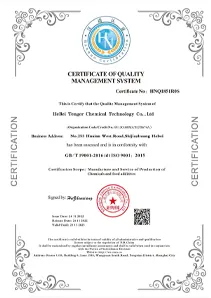
Exploring the Benefits and Applications of Emulsifier E433 in Food and Cosmetic Industries
Understanding Emulsifier E433 Composition, Uses, and Safety
Emulsifiers are vital components in a variety of food, cosmetic, and pharmaceutical products. Among the numerous emulsifiers available, E433, also known as Polysorbate 80, has gained significant attention due to its versatile applications and effectiveness in stabilizing mixtures. Understanding the composition, uses, and safety concerns surrounding E433 is essential for both manufacturers and consumers alike.
Composition and Properties
E433 is a non-ionic emulsifier, primarily derived from sorbitol, a sugar alcohol, and fatty acids from natural sources such as palm oil or tallow. The chemical structure of Polysorbate 80 consists of a hydrophilic head and a hydrophobic tail, which allows it to reduce the surface tension between oil and water, enabling them to blend more effectively. This unique property is what makes E433 a popular choice in emulsifying fats and oils with water.
The emulsifier is available in a clear, slightly yellow liquid form and is characterized by its mild, sweet odour. It is soluble in both water and oil, making it an excellent agent for various formulations. In addition to its emulsifying properties, E433 also acts as a thickening and stabilizing agent, which further expands its utility in many products.
Applications in Various Industries
E433 is commonly used in the food industry as an emulsifying agent for different culinary applications. It is found in a range of products, including ice creams, salad dressings, sauces, and baked goods. E433 helps to maintain a uniform texture and consistency in these products, preventing separation and improving mouthfeel.
emulsifier 433

In the cosmetic industry, Polysorbate 80 is utilized in lotions, creams, and shampoos, where it serves a similar purpose. It helps to blend oil and water components, ensuring a stable formulation that is easy to apply and absorb. Additionally, E433 is advantageous in pharmaceutical products, where it aids in the solubilization of active ingredients, ensuring effective delivery to the intended site of action.
Safety and Regulatory Status
The safety of emulsifiers like E433 has been the subject of extensive research. Regulatory agencies such as the European Food Safety Authority (EFSA) and the U.S. Food and Drug Administration (FDA) have evaluated the safety of Polysorbate 80 and deemed it safe for use within specified limits. The acceptable daily intake established by these authorities allows for its inclusion in food products without posing a risk to health.
However, like any additive, E433 may cause allergic reactions in sensitive individuals. Some people may experience gastrointestinal issues or skin irritations as a result of consuming or coming into contact with products containing this emulsifier. Hence, it is essential for consumers to read labels carefully, especially if they have known sensitivities or allergies.
Conclusion
Emulsifier E433, or Polysorbate 80, plays a crucial role in various industries, particularly in food, cosmetics, and pharmaceuticals. Its effectiveness as an emulsifying agent helps to create stable and appealing products. While largely regarded as safe, it is vital for consumers to remain informed about potential sensitivities. As the demand for emulsifiers continues to grow, further research and development may lead to innovative applications and the enhancement of existing formulations, ensuring that products meet the highest standards of quality and safety.
-
nitrile-rubber-honoring-strict-production-standardsNewsAug.22,2025
-
aspartame-ingredients-honoring-food-safety-valuesNewsAug.22,2025
-
fertilizer-for-balanced-plant-nutritionNewsAug.22,2025
-
cyanide-gold-processing-with-high-purity-additivesNewsAug.22,2025
-
formic-acid-in-textile-dyeing-applicationsNewsAug.22,2025
-
aluminum-hydroxide-gel-in-skincare-productsNewsAug.22,2025
-
Regulatory Compliance for Global Mining Chemicals UseNewsAug.12,2025
Hebei Tenger Chemical Technology Co., Ltd. focuses on the chemical industry and is committed to the export service of chemical raw materials.
-

view more DiethanolisopropanolamineIn the ever-growing field of chemical solutions, diethanolisopropanolamine (DEIPA) stands out as a versatile and important compound. Due to its unique chemical structure and properties, DEIPA is of interest to various industries including construction, personal care, and agriculture. -

view more TriisopropanolamineTriisopropanolamine (TIPA) alkanol amine substance, is a kind of alcohol amine compound with amino and alcohol hydroxyl, and because of its molecules contains both amino and hydroxyl. -

view more Tetramethyl Thiuram DisulfideTetramethyl thiuram disulfide, also known as TMTD, is a white to light-yellow powder with a distinct sulfur-like odor. It is soluble in organic solvents such as benzene, acetone, and ethyl acetate, making it highly versatile for use in different formulations. TMTD is known for its excellent vulcanization acceleration properties, which makes it a key ingredient in the production of rubber products. Additionally, it acts as an effective fungicide and bactericide, making it valuable in agricultural applications. Its high purity and stability ensure consistent performance, making it a preferred choice for manufacturers across various industries.





